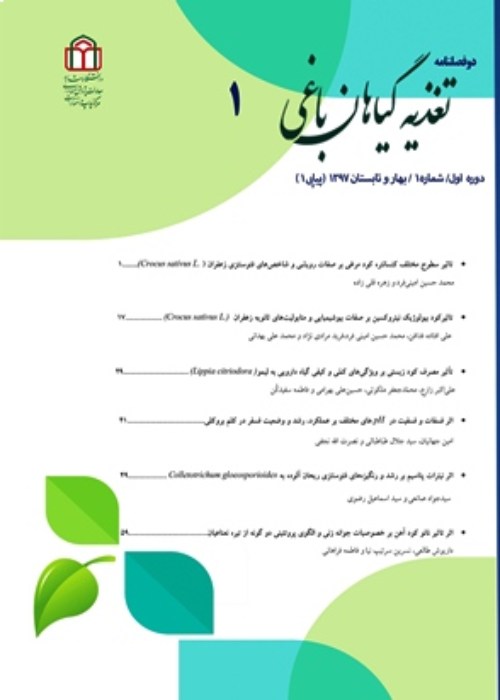Morphophysiological response of basil under carbon dioxide and ethanol nutrition
The side effects of chemical drugs have resulted in more attention from humans to use medicinal plants and their extract ingredients to treat many diseases. Basil (Ocimum basilicum) is a medicinal plant from the Lamiaceae family that is used in the food and cosmetic industries. Due to the serious problems in the past decades resulting in the excessive application of chemical inputs and plant growth regulators to enhance agricultural production, nowadays, the need for new technologies to produce safe food and protect the environment has been of great interest to the international community. In this regard, the application of alcohols, especially ethanol and methanol solutions, to improve the performance of plants in the agricultural systems is important. The use of foliar application of methanol and ethanol on the aerial parts of different plants propound as one of the newest strategies to increase growth and their yield. Short-term exposure to elevated CO2 for plants generally leads to an increase in the rates of leaf-level photosynthesis due to enhance the activity of ribulose-1.5-bisphosphate carboxylase/oxygenase (Rubisco). The response to elevated CO2 results in an increase in leaf area, biomass accumulation, or individual plant size.
To study the morphophysiological response of basil cv. keshkeni luvelou under CO2 and ethanol nutrition, a pot experiment was conducted at the research greenhouse of Ferdowsi University of Mashhad as factorial based on a completely randomized design with three levels of CO2 (380, 700, and 1050 mg/L) and four levels of ethanol foliar application (0, 10, 20 and 30 %v/v) in three replications in 2019. The studied traits were included growth characteristics (plant height, number of branches, stem diameter, internode distance, and fresh and dry weight of the aerial part) and photosynthetic pigments (chlorophyll a, chlorophyll b, carotenoid, and total chlorophyll), antioxidant activity, total phenol, and essential oil content. Statistical analysis was performed using Minitab 17 software. The mean comparison was done by the Bonferroni test at the 5% probability level. The figures drew by Microsoft excel software.
The results of the mean comparisons showed that, with increasing ethanol concentration, the growth characteristics of the plant increased, and also the application of 700 mg/L carbon dioxide was able to increase the growth characteristics of the plant. Application of 700 mg/L CO2 and foliar application of ethanol (20%v/v) increased chlorophyll a, chlorophyll b, and total chlorophyll by 72.18, 74.01, and 71.33%, respectively compared to 380 mg/L CO2 and no ethanol application. The results also showed that the highest antioxidant activity (87.38%) and total phenol (264 mg g fresh leaf weight) higher than control at 700 mg/L CO2 and 20 %v/v ethanol foliar application. The highest essential oil content was observed at 1050 mg/L CO2 and 30%v/v ethanol. The results of this experiment showed that the use of CO2 and ethanol by affecting plant metabolites and improving photosynthesis can affect the morphophysiological characteristics of the basil.
Based on the results of this experiment, the growth characteristics, photosynthetic pigments, antioxidant activity, total phenol, and essential oil content of O. basilicum cv. Keshkeni luvelu was influenced by CO2 and ethanol. At 700 mg/L CO2 and 20%v/v ethanol application due to the effect on these compounds in improving photosynthesis, the highest growth characteristics were observed. While the highest essential oil content was observed in the highest levels of carbon dioxide and ethanol foliar application. Therefore, according to the results of this study to achieve the highest yield of basil, 700 mg/L CO2 and 20%v/v ethanol application is recommended.
- حق عضویت دریافتی صرف حمایت از نشریات عضو و نگهداری، تکمیل و توسعه مگیران میشود.
- پرداخت حق اشتراک و دانلود مقالات اجازه بازنشر آن در سایر رسانههای چاپی و دیجیتال را به کاربر نمیدهد.



